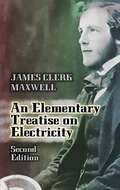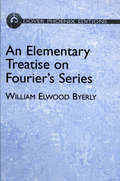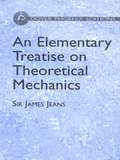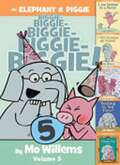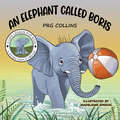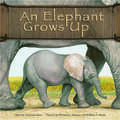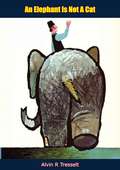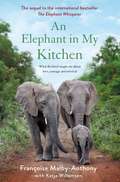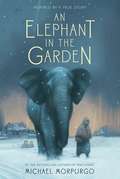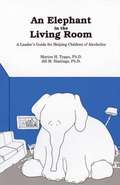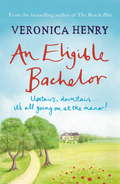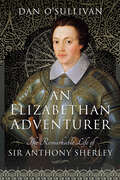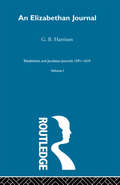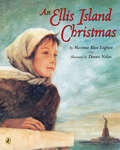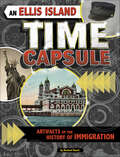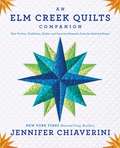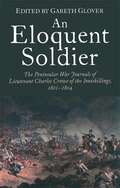- Table View
- List View
An Elementary Treatise on Electricity: Second Edition (Dover Books on Physics)
by James Clerk MaxwellAlbert Einstein characterized the work of James Clerk Maxwell as the "most profound and the most fruitful that physics has experienced since the time of Newton." Max Planck went even further, declaring that "he achieved greatness unequalled," and Richard Feynman asserted that "From a long view of the history of mankind -- seen from, say, ten thousand years from now -- there can be little doubt that the most significant event of the nineteenth century will be judged as Maxwell's discovery of the laws of electrodynamics." Maxwell made numerous other contributions to the advancement of science, but the greatest work of his life was devoted to electricity. An Elementary Treatise on Electricity appeared at a time when very few books on electrical measurements were available to students, and its compact treatment not only elucidates the theory of electricity but also serves to develop electrical ideas in readers' minds. The author describes experiments that demonstrate the principal facts relating an electric charge as a quantity capable of being measured, deductions from these facts, and the exhibition of electrical phenomena.This volume, published posthumously from Maxwell's lecture notes at the Cavendish Laboratory -- which he founded at the University of Cambridge -- is supplemented by a selection of articles from his landmark book, Electricity and Magnetism. A classic of science, this volume is an eminently suitable text for upper-level undergraduates and graduate students.
An Elementary Treatise on Fourier's Series: and Spherical, Cylindrical, and Ellipsoidal Harmonics, with Applications to Problems in Mathematical
by William Elwood ByerlyOriginally published over a century ago, this work remains among the most useful and practical expositions of Fourier's series, and spherical, cylindrical, and ellipsoidal harmonics. The subsequent growth of science into a diverse range of specialties has enhanced the value of this classic, whose thorough, basic treatment presents material that is assumed in many other studies but seldom available in such concise form. The development of functions, series, and their differential equations receives detailed explanations, and throughout the text, theory is applied to practical problems, with the solutions fully worked out. In addition, 190 problems, many with hints, are included. 1893 edition. Appendix of 6 tables.
An Elementary Treatise on Theoretical Mechanics (Dover Books on Physics)
by Sir James JeansIn addition to being among the twentieth century's major scientific figures, Sir James Jeans (1877-1946) was also one of the greatest modern science expositors. His classic introduction to mechanics endures as a clear and concise presentation of first principles.Although brief, it encompasses a remarkably wide selection of topics. Its subjects include rest and motion, force and the laws of motion, forces acting on a single particle, statics of systems of particles, statics of rigid bodies, center of gravity, work, motion of a particle under constant forces, motion of systems of particles, motion of a particle under a variable force, motion of rigid bodies, and generalized coordinates. Within each chapter, the author carefully explains the most elementary concepts (such as velocity, acceleration, Newton's laws, friction, moments, and kinetic energy), and he illustrates them with examples.Ideal for beginning physics students or for more advanced readers in need of refreshment, the text emphasizes the fundamental physical principles rather than mathematics or applications. So clearly written that it can be read and understood outside the classroom, it features hundreds of fully worked illustrative examples and test exercises.
An Elephant And Piggie Biggie!: Volume 5 (An Elephant And Piggie Book)
by Mo WillemsFor the fifth time ever, best friends Elephant and Piggie have five BIGGIE adventures in one book! From award-winning, best-selling author and illustrator Mo Willems, this BIGGIE bind-up of Elephant & Piggie adventures will make readers want to celebrate! This bind-up includes the titles: I Am Invited to a Party!; I Will Surprise My Friend!; Happy Pig Day!; Waiting IsNot Easy!; and The Thank You Book.
An Elephant Called Boris
by Prg CollinsBoris didn’t know the dangers of taking drugs, and he never really thought about drugs until some people suggested he try the fruit of the Marula tree which can cause you to do strange things if you eat it. They made him feel like a weak elephant if he didn’t try it, so Boris said ‘Okay’ even though he didn’t really want to do it! What happened to Boris after he ate it was terrible. Find out what strange and wrongs things he did and how he felt! And learn the lesson from Boris, that taking drugs, no matter who tried to talk you into it, is wrong and dangerous for you!
An Elephant Grows Up (Wild Animals)
by Anastasia SuenDescribes the development of elephants from infancy to adulthood, as they grow up under the hot African sun.
An Elephant In The Living Room: The Children's Book
by Marion H. Typpo Jill M. HastingsAn illustrated story to help children understand and cope with the problem of alcoholism or other drug addiction in the family. An illustrated story to help children understand and cope with the problem of alcoholism or other drug addiction in the family.
An Elephant Is Not A Cat
by Alvin Tresselt Wilbur WheatonPieter Vanderloon was a very fortunate man. He had a fine fat wife, six roly-poly children, and a mill overflowing with corn.One morning there were four less kernels of corn in the mill, for two tiny mice had made a breakfast of them.Off went Pieter at once to buy a cat to guard his corn. But, instead, he came back with an elephant! “From the tip of his trunk to the end of his tail, there is far more to an elephant than there is to a cat!” Pieter told his astonished wife. Besides, the elephant cost nothing but a promise never to return it.Why Pieter soon finds out!
An Elephant in My Kitchen: What the Herd Taught Me About Love, Courage and Survival (Elephant Whisperer #2)
by Françoise Malby-Anthony Katja WillemsenTHE INTERNATIONAL BESTSELLER"Malby-Anthony offers a book of great inspiration and wide appeal to nature-loving readers." —Publishers WeeklyA heart-warming sequel to the international bestseller The Elephant Whisperer, by Lawrence Anthony's wife Françoise Malby-Anthony. A chic Parisienne, Françoise never expected to find herself living on a South African game reserve. But then she fell in love with conservationist Lawrence Anthony and everything changed. After Lawrence’s death, Françoise faced the daunting responsibility of running Thula Thula without him. Poachers attacked their rhinos, their security team wouldn’t take orders from a woman and the authorities were threatening to cull their beloved elephant family. On top of that, the herd’s feisty new matriarch Frankie didn’t like her.In this heart-warming and moving book, Françoise describes how she fought to protect the herd and to make her dream of building a wildlife rescue center a reality. She found herself caring for a lost baby elephant who turned up at her house, and offering refuge to traumatized orphaned rhinos, and a hippo called Charlie who was scared of water. As she learned to trust herself, she discovered she’d had Frankie wrong all along.Filled with extraordinary animals and the humans who dedicate their lives to saving them, An Elephant in My Kitchen is a captivating and gripping read.
An Elephant in the Garden
by Michael MorpurgoLizzie and Karl’s mother is a zoo keeper; the family has become attached to an orphaned elephant named Marlene, who will be destroyed as a precautionary measure so she and the other animals don’t run wild should the zoo be hit by bombs. The family persuades the zoo director to let Marlene stay in their garden instead. When the city is bombed, the family flees with thousands of others, but how can they walk the same route when they have an elephant in tow, and keep themselves safe? Along the way, they meet Peter, a Canadian navigator who risks his own capture to save the family. As Michael Morpurgo writes in an author’s note, An Elephant in the Garden is inspired by historical truths, and by his admiration for elephants, “the noblest and wisest and most sensitive of all creatures.” Here is a story that brings together an unlikely group of survivors whose faith in kindness and love proves the best weapon of all.
An Elephant in the Living Room: A Leader's Guide for Helping Children of Alcoholics
by Marion H. Typpo Jill M. HastingsPerfect for individual use or in group settings, professionals and other adult helpers will learn basic information in order to help children cope with an addicted parent or sibling. Professionals and other adult helpers will learn basic information in order to help children cope with an addicted parent or sibling. Offers practical guidance to education and health care professionals who help young people cope with a family member's chemical dependency as it explains the disease of chemical dependency and the psychology of child development. Excellent for use in either children's support groups or individual settings.
An Elf to Myself (2019 Advent Calendar | Homemade for the Holidays #4)
by Emy CalirelThe last thing Wilhelm expects to find at Michaels, three days before Christmas and in search of a gift to make for his niece, is one of Santa’s elves—a cute one with a wicked, inappropriate sense of humor and a kinky streak. Alabastair may have been kicked out of Santa’s village, but he’s still a Christmas expert. And he’s determined to give Wilhelm and his family the best holiday he can. With only two days to turn the Grinch’s house into a Christmassy wonderland, they have a lot on their plate. Among the glitter and the cheer, Wilhelm and Alabastair might find more than just the holiday’s magic. But will it be enough to keep Alabastair in Wilhelm’s bed and life when the North Pole calls him back?A story from the Dreamspinner Press 2019 Advent Calendar "Homemade for the Holidays."
An Eligible Bachelor
by Veronica HenryWelcome to Eversleigh--a small English village being invaded by celebrity, sex, and scandal! Guy Portias, heir to Eversleigh Manor, has woken up with two problems: he has a wicked hangover, and he seems to have gotten himself engaged. His new fiancée, Richenda Fox, is the gorgeous star of the hottest new TV series in England, but is the enigmatic beauty the right woman for him? To complicate matters, Eversleigh is badly in need of repairs, and the family fortune has run a bit dry. When Guy reluctantly agrees to let his mother run "Country House Weekends" at the manor, they hire Honor McLean, a bewitching single mother, to cater and help them deal with the chaos. Warm and down to earth, Honor is nothing like Guy's cool, career-obsessed fiancée. If Honor's wit and charm have the same effect on others that they seem to have on Guy, she could end up saving Eversleigh on her own--and stealing Guy's heart in the process. With a cast of characters you'll love (and a few you'll love to hate), An Eligible Bacheloris a charming, sexy, and compulsively readable romp through the English countryside. Also available as an eBook From the Trade Paperback edition.
An Eligible Bachelor
by Veronica HenryUpstairs, downstairs... it's all going on at the manor.From the bestselling author of THE LONG WEEKEND and A NIGHT ON THE ORIENT EXPRESS.Before THE BEACH HUT there was AN ELIGIBLE BACHELOR...When Guy wakes up with a terrible hang-over and a new fiancée, he tries not to panic. After all, Richenda is beautiful, famous, successful... What reason could he have for doubts?As news of the engagement between the heir of Eversleigh Manor and the darling of prime-time television spreads through the village, Guy wonders if he's made a rash decision. Especially when he meets Honor, a new employee of the Manor who has a habit of getting under his skin...But Honor has her own troubles - a son who's missing a father, and an ex-boyfriend who has made an unexpected reappearance...
An Eligible Bachelor
by Veronica HenryUpstairs, downstairs... it's all going on at the manor.From the bestselling author of THE LONG WEEKEND and A NIGHT ON THE ORIENT EXPRESS.Before THE BEACH HUT there was AN ELIGIBLE BACHELOR...When Guy wakes up with a terrible hang-over and a new fiancée, he tries not to panic. After all, Richenda is beautiful, famous, successful... What reason could he have for doubts?As news of the engagement between the heir of Eversleigh Manor and the darling of prime-time television spreads through the village, Guy wonders if he's made a rash decision. Especially when he meets Honor, a new employee of the Manor who has a habit of getting under his skin...But Honor has her own troubles - a son who's missing a father, and an ex-boyfriend who has made an unexpected reappearance...
An Eligible Man
by Rosemary FriedmanHis Honour Judge Christopher Osgood is utterly unprepared for life on his own when his wife dies. He is completely overwhelmed by a desperate loneliness and he finds himself bewildered by anything from the absence of clean pyjamas to the dress code of his daughters. But as the months pass, he discovers that, as an attractive and eligible widower in late middle age, he is much in demand. Lucille mothers and seduces him, Sally offers friendship and Jo introduces him to her stylish town and country life - but with which one will he find the happiness he has lost and the contentment he is seeking?
An Eligible Man
by Rosemary FriedmanHis Honour Judge Christopher Osgood is utterly unprepared for life on his own when his wife dies. He is completely overwhelmed by a desperate loneliness and he finds himself bewildered by anything from the absence of clean pyjamas to the dress code of his daughters. But as the months pass, he discovers that, as an attractive and eligible widower in late middle age, he is much in demand. Lucille mothers and seduces him, Sally offers friendship and Jo introduces him to her stylish town and country life - but with which one will he find the happiness he has lost and the contentment he is seeking?
An Elizabethan Adventurer: The Remarkable Life of Sir Anthony Sherley
by Dan O'SullivanAnthony Sherley (1565-1633) was one of three brothers from a Sussex gentry family, whose adventures abroad fascinated their contemporaries. Their doings were celebrated and exaggerated in printed pamphlets and a play on the London stage, but are scarcely known today. Anthony was a soldier fighting in France and the Netherlands, and then an unsuccessful privateer, before his patron, the earl of Essex, chose him to lead a group on a mission to Ferrara, which proved abortive. Sherley then undertook on his own initiative to take his followers on a highly risky journey across Turkey to Persia. He hoped to persuade the Shah to ally with the West against their mutual enemy, Ottoman Turkey. Surprisingly, Shah Abbas the Great (1587-1629) approved the plan, and sent Sherley back to Europe as his ambassador. But after that things went badly wrong. Essex lost all influence at court, and was eventually executed for treason. Sherley was refused permission to return to England. He was on his own, and had to find new ways of living and earning. After various episodes in Venice and Morocco he ended up in the pay of Spain, and was chosen to command a fleet created to stop pirates from attacking Spanish possessions. After the failure of this project he was forced to retire to Granada, and lived the rest of his life on a meagre royal pension. But he continued trying to give advice, based on his past experiences, to the king of Spain and his ministers. The book will concentrate on Sherley’s career, but will broaden the theme by including chapters on his father and his two brothers, and in particular on Persia and Shah Abbas, the Persian king whom he met. Anthony was an irascible, complex character, often derided and disliked. This biography is more sympathetic than previous ones, and discusses his self-fashioning and his belief in his personal honour, both of which might account for some of his misdemeanours, especially after the death of his patron.
An Elizabethan Journal V1
by G.B. HarrisonFirst Published in 1999. Routledge is an imprint of Taylor & Francis, an informa company.
An Ellis Island Christmas
by Maxinne Rhea LeightonA moving story about one family's daring journey from Poland to America and their hope for a better future in their new home. Krysia does not want to leave her home and her friend, Michi, but there are soldiers with guns on the streets and her mother says that they must go. Krysia, her two brothers, and her mother pack their favorite belongings and begin the long, harrowing journey to America. Krysia is scared but she finds courage when she thinks of her father waiting for her in America with the promise of a better tomorrow.Inspired by Maxinne Rhea Leighton's father's journey from Poland to America, this is a powerful reminder of the beacon of hope and opportunity that Ellis Island symbolized and the importance of family at Christmastime.
An Ellis Island Time Capsule: Artifacts of the History of Immigration
by Rachael HanelThe artifacts of Ellis Island tell the story of millions of immigrants who passed through its halls on their journey to a new life in the United States. A 1900 photograph of the Statue of Liberty, an antique stethoscope, and a jigsaw puzzle are some of the primary sources that can help students better understand the experience of journeying through Ellis Island in the early 1900s. Explore these and more in this Time Capsule History book!
An Ellis Island Time Capsule: Artifacts of the History of Immigration
by Rachael HanelThe artifacts of Ellis Island tell the story of millions of immigrants who passed through its halls on their journey to a new life in the United States. A 1900 photograph of the Statue of Liberty, an antique stethoscope, and a jigsaw puzzle are some of the primary sources that can help students better understand the experience of journeying through Ellis Island in the early 1900s. Explore these and more in this Time Capsule History book!
An Ellis Island Time Capsule: Artifacts of the History of Immigration (Time Capsule History)
by Rachael HanelThe artifacts of Ellis Island tell the story of millions of immigrants who passed through its halls on their journey to a new life in the United States. A 1900 photograph of the Statue of Liberty, an antique stethoscope, and a jigsaw puzzle are some of the primary sources that can help students better understand the experience of journeying through Ellis Island in the early 1900s. Explore these and more in this Time Capsule History book!
An Elm Creek Quilts Companion
by Jennifer ChiaveriniA beautiful keepsake volume to accompany the beloved New York Times bestselling series Over the course of the bestselling Elm Creek Quilts series, readers have expressed a longing to visit Elm Creek Manor, meet the quilters themselves, and admire their beautiful creations. Jennifer Chiaverini’s An Elm Creek Quilts Companion is the next best thing to a guided tour. Inside, readers will discover a treasure trove of delights, including the Bergstrom family tree, character biographies, quilt block illustrations, full-color photographs of quilts featured in the novels, and "Behind the Scenes at Elm Creek Quilt Camp,” an exclusive short story inspired by questions from real readers. No Elm Creek Quilts fan will want to be without this indispensable guide to the cherished series. .
An Eloquent Soldier: The Peninsular War Journals of Lieutenant Charles Crowe of the Inniskillings, 1812-14
by Gareth GloverLieutenant Charles Crowe's journal of the 27th Foot (Inniskillings) of the final campaign of Wellington's army is a rare work for many reasons. It is, perhaps surprisingly, the first memoir about this campaign from this famous regiment to be published.Crowe wrote a daily journal at the time, which practically guarantees the authenticity and accuracy of his account. But what makes it special is that Crowe was extremely well read and was an accomplished writer, so that when he wrote up his journal in 18423, he was able to embellish his basic journal, describing his thoughts, actions and words in beautiful detail. He thus turned his record of his short army career into a masterpiece of journalism. Clearly written purely for the enjoyment of his family, Crowe does not pull his punches: he censures officers both junior and senior; he talks openly of the ravages of war, and the pillaging, raping and looting; the horrors of war, describing the deaths and horrific wounds of many in lurid detail, the cowardice and stupidity; and he also describes the mundane in detail nothing is passed over.Crowe is an invaluable source to military historians on many levels, and his journal will stand proudly deservedly in the pantheon of great military memoirs.
